Slot Loaded Open Baffle is not same as W frame, but they share some features
http://www.enjoythemusic.com/diy/0911/slot_loaded_open_baffle_speaker.htm
https://www.diyaudio.com/community/threads/pass-open-baffle-need-help.300952/
https://www.linkwitzlab.com/woofer.htm
https://www.hifizine.com/2012/12/subwoofer-origami/
http://www.enjoythemusic.com/diy/0911/slot_loaded_open_baffle_speaker.htm
https://www.diyaudio.com/community/threads/pass-open-baffle-need-help.300952/
https://www.linkwitzlab.com/woofer.htm
https://www.hifizine.com/2012/12/subwoofer-origami/
I was using N frame in the past, except I called it Z frame, depending how you look at it.
Now I use something which is not in the list. Something like Emerald Physics or Legacy, two woofers behind each other.
Now I use something which is not in the list. Something like Emerald Physics or Legacy, two woofers behind each other.
I assume the sloat is to produce a compression and focus the bass flow by a narrow open chamber in front of the listener... Make me think a lot of the aperiodic bass cabinet while not working the same.
I don’t think the W has much cone loading or front jet acceleration to give directional gain like a SLOB. I did not try without side walls yet but know from physics that the bass would be much higher cutoff. Nelson Pass’ SLOB had no side walls but a much wider baffle so same effect I think.
Speaking of Z frame dipole, I made the KaZBa design and CLS had a beautiful implementation with dual 18in woofers.
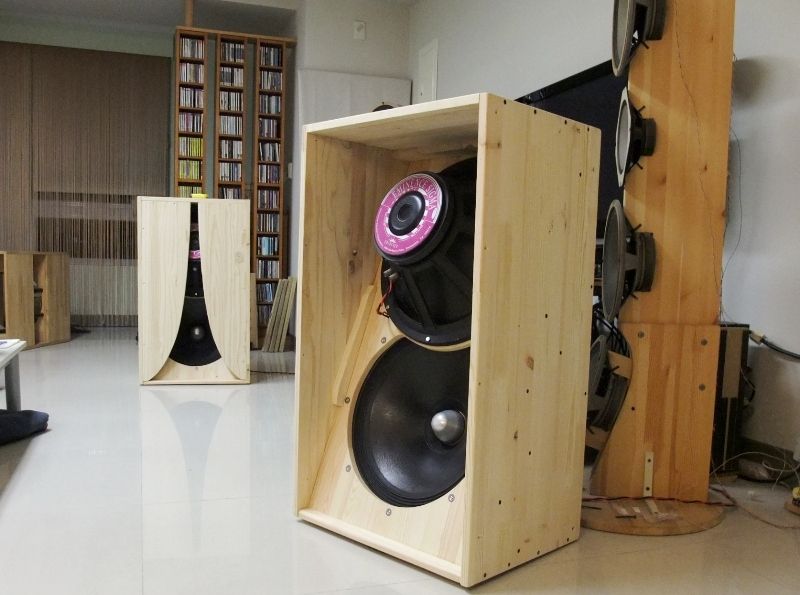
Speaking of Z frame dipole, I made the KaZBa design and CLS had a beautiful implementation with dual 18in woofers.

Actually a slot "loads" only in extreme nearfield. At practical listening distance and regarding dipole pattern formation, it is irrelevant, and easily has nasty cavity- and mechanical resonances in upper register. And I have never seen 180deg polars of eg. Nelson Pass SLOB woofer... my impression is that they gave no thinking at all to dipole pattern and just made it as a funny excercise. I fail to see any benefits in it.
The slot itself does nothing to directivity in bass frequencies. Please consider wavelengths!
I have also made a 2x15" closed box slot loaded push-pull subwoofer, and measured it in 2013, for my HT room. The closed end of the slot is stuffed with a pillow
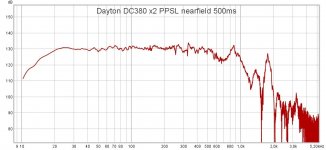
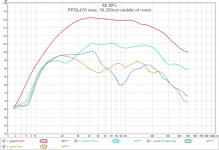
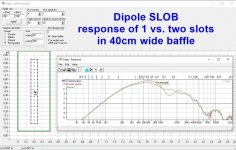
The slot itself does nothing to directivity in bass frequencies. Please consider wavelengths!
I have also made a 2x15" closed box slot loaded push-pull subwoofer, and measured it in 2013, for my HT room. The closed end of the slot is stuffed with a pillow



Last edited:
I one can understand the push pull arrengement to cancel box vibrations...it seems less evident in a no baffle hanging bass like seen above in the gallery
Whatever you do the front to back cancelation always occurs when the backwave after having bouncing of the room wall meet the front wave.
So the farer from the wall the less biquad compensation needed to EQ lift the low end...and the more we go back to classic presurization?
Due to the wave length of the bass have we still 8 figure radiation patern ? The papers seems to says the main advantage of the ob bass is it no enhance rooms modes
I understand it as a non 360 degree radiation effect and the fact the ob bass should be near the listeners...
Whatever you do the front to back cancelation always occurs when the backwave after having bouncing of the room wall meet the front wave.
So the farer from the wall the less biquad compensation needed to EQ lift the low end...and the more we go back to classic presurization?
Due to the wave length of the bass have we still 8 figure radiation patern ? The papers seems to says the main advantage of the ob bass is it no enhance rooms modes
I understand it as a non 360 degree radiation effect and the fact the ob bass should be near the listeners...
^ Yes quite many "if"s... And a room has it's Schröder Fs, below which we humans will hear only the room response (regarding spl).
Travel time of first wavefront (timing, EGD) and decay are another ways to look at impulse response at listening spot. Hearability of EGD of low freq is controversial, but as a multiway-dsp fanboy I've found it important too! Attack and slam, you know...
Travel time of first wavefront (timing, EGD) and decay are another ways to look at impulse response at listening spot. Hearability of EGD of low freq is controversial, but as a multiway-dsp fanboy I've found it important too! Attack and slam, you know...
Last edited:
I do notice that the SLOB has much more uniform bass in the room vs traditional monopole speakers. Much less distinctive peaks and nulls in sub 100Hz bass when walking around. The slot actually filters out some of the woofer’s own natural high frequency breakup and if the electrical low pass is made to coincide with the acoustic low pass, we get a steep higher order filter for the price of a lower order electrical. This is predominantly determined by the slot depth.^ Yes quite many "if"s... And a room has it's Schröder Fs, below which we humans will hear only the room response (regarding spl).
Travel time of first wavefront (timing, EGD) and decay are another ways to look at impulse response at listening spot. Hearability of EGD of low freq is controversial, but as a multiway-dsp fanboy I've found it important too! Attack and slam, you know...
Juhazi, your push pull SLOB looks great. Thanks for sharing.
Juhazi, your push pull SLOB looks great. Thanks for sharing
? I have never made even a proto of SLOB. I made a PPSL subwoofer, where each driver has huge closed box
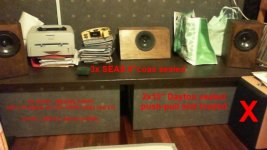
Kallbo linked this https://www.lindstromaudio.com/products
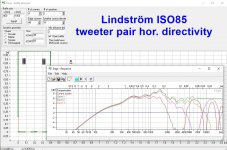
? I have never made even a proto of SLOB. I made a PPSL subwoofer, where each driver has huge closed box

Kallbo linked this https://www.lindstromaudio.com/products

Last edited:
Oops sorry I misunderstood - I saw push pull slot loading and assumed we are talking OB’s here. 🙂 so the back is closed box and slot out the front?
yep we are talking open back here 😎... in the meantime nothing hurting to talk about where the equilibrium crossover point with another load could work better for the ears - it ceratinly asks a dedicated thread to let this thread mainly a gallery one, though)
SLOB
Siegfried Linkwitz Open Back
Slot Loaded Open Baffle
Is really a mullet speaker design inspired by to many edibles on the deck at the coast of California.
It is Black-Tie in the front and Bernadette Peters curls in the back.
Because this is a visual thread.
Thanks DT

Siegfried Linkwitz Open Back
Slot Loaded Open Baffle
Is really a mullet speaker design inspired by to many edibles on the deck at the coast of California.
It is Black-Tie in the front and Bernadette Peters curls in the back.
Because this is a visual thread.
Thanks DT
New paint job on the baffle and a new name as “SLOB” wasn’t so sexy. The XSD speaker now has its own dedicated thread here.


Open baffle consisting of 4 TangBand w8-2145 in parallel. Build based on ECdesigns' specifications.
Sound is very natural, high resolution. Bass is solid.
- Home
- Loudspeakers
- Multi-Way
- Ultimate Open Baffle Gallery